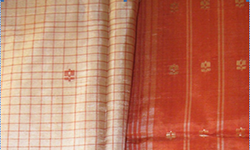
Art history/ Historiography, Crafts, Handlooms, Art, Craftspersons/ Artisanal
Colours of Kutch: The Art of the Khatris of Dhamadka
Edwards, Eiluned
The dyeing and printing of fabric has been practiced on the Indian sub-continent since ancient times. Originally centred on Sind, part of Pakistan since Partition in 1947, the province is referred to as suvasa (‘the maker of good cloth’) in the Rig-Veda Samitha, written in the second millennium BC. The Romans were familiar with the Sindi cloths and, in the first century AD, cloth imported from the East was known as cendatus, or ‘Sindi cloth’. The earliest surviving examples of patterned cottons from the sub-continent were retrieved from Fostat, the harbour of Old Cairo. The provenance of the ‘Fostat’ textiles is Gujarat and they have recently been carbon dated to 1275 m (z75). Sind, Gujarat and neighboring Rajasthan, are centres for printing and dyeing cloth to this day. The business is dominated by the Khatri caste, who are predominantly Muslims in Sind and Gujarat, and Hindus in Rajasthan, One of the areas with the greatest, concentration of Khatri dyers and printers, is the desert region of Kachchh District in Gujarat.



